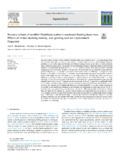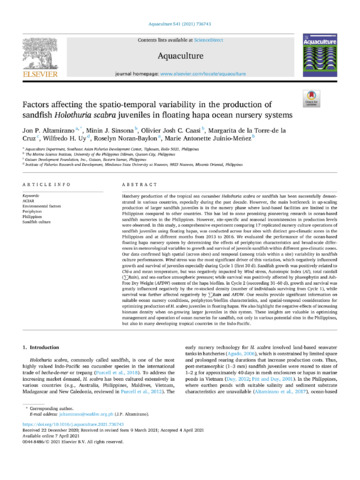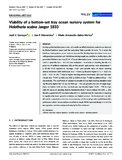Nursery culture of sandfish Holothuria scabra in sea-based floating hapa nets: Effects of initial stocking density, size grading and net replacement frequency
Share
抄録
Sea-based culture of early juvenile sandfish Holothuria scabra up to fingerling size (>2 g) using floating hapa nets has been confirmed as a viable nursery system in tropical countries such as the Philippines. However, production can be further optimized through more efficient rearing practices. In this study, we demonstrate the effects of initial stocking density, size grading and net replacement frequency during the culture of early juvenile sandfish in sea-based floating hapa nets (2 × 1 × 1 m). Testing different initial stocking density treatments ranging from 150 to 2000 early juveniles (4–10 mm; 0.02–0.06 g) per hapa net, we confirmed significantly faster growth (0.06–0.08 g d−1) and higher survival (72–97%) in low densities (≤500 hapa−1), compared to high densities (≥700 hapa−1: 0.02–0.04 g d−1; 67–80%). Low density culture can produce 2 g sandfish in about a month, while higher densities will require a 2–3 mo culture period to reach this size. Culture performance following size grading was also compared using three initial size classes (small, 0.05–0.99 g; medium, 1–1.99 g; and large, 2–3 g) and a mixed group (0.05–3.00 g). At 45 d, juveniles in pooled size-graded groups grew significantly faster (0.11–0.13 g d−1) than those in the mixed group (0.01 g d−1). Survival was significantly higher in the medium (85.3%) and large (84.7%) groups, than those in the small (54.4%) and mixed (45.6%) groups. However, size variation was not significantly mitigated by grading during the 45-d culture. Culture performance of sandfish was not significantly enhanced by more frequent net replacement for short-term rearing (30–45 d). Optimal results were gained from an initial stocking density of ≤500 early juveniles (5–10 mm) per floating hapa net which may be cultured in a month, without requiring net replacement and size grading to produce ≥2 g sandfish. However, in cases of high hatchery production, it is also feasible to adopt higher density stocking (e.g. >1000 hapa−1), but will require longer culture duration (60–85 d), monthly net replacement and size-grading to attain the same size. Results of this study can help fine-tune management practices for nursery culture of sandfish in sea-based floating hapa net nurseries in order to boost production of fingerlings needed for aquaculture and restocking.
Suggested Citation
Altamirano, J., & Noran-Baylon, R. D. (2020). Nursery culture of sandfish Holothuria scabra in sea-based floating hapa nets: Effects of initial stocking density, size grading and net replacement frequency. Aquaculture , 526, 735379. https://doi.org/10.1016/j.aquaculture.2020.735379
Taxonomic term
Collections
- AQD Journal Articles [1249]
Related items
Showing items related by title, author, creator and subject.
-
Factors affecting the spatio-temporal variability in the production of sandfish Holothuria scabra juveniles in floating hapa ocean nursery systems
Altamirano, Jon; Sinsona, Minin; Caasi, Olivier Josh; de la Torre-de la Cruz, Margarita; Uy, Wilfredo; Baylon, Roselyn; Juinio-Meñez, Marie Antonette (Elsevier, 2021-04)Hatchery production of the tropical sea cucumber Holothuria scabra or sandfish has been successfully demonstrated in various countries, especially during the past decade. However, the main bottleneck in up-scaling production ... -
Viability of a bottom-set tray ocean nursery system for Holothuria scabra Jaeger 1833
Gorospe, Jay R. C.; Altamirano, Jon; Juinio-Meñez, Marie Antonette (Wiley, 2017)Scaling up the hatchery production of juvenile sandfish Holothuria scabra is constrained by limited hatchery space and the associated high operational costs. To shorten the hatchery rearing phase, ocean nursery systems ... -
Approaches in Rebuilding Sea Urchin and Sea Cucumber Populations in the Philippines
Meñez, Marie Antonette J. (Training Department, Southeast Asian Fisheries Development Center, 2016)Sea urchins and sea cucumbers are among the most valuable and overexploited fishery resources. Culture and release of juvenile Tripneustes gratilla and Holothuria scabra have been undertaken to rebuild depleted populations ...





